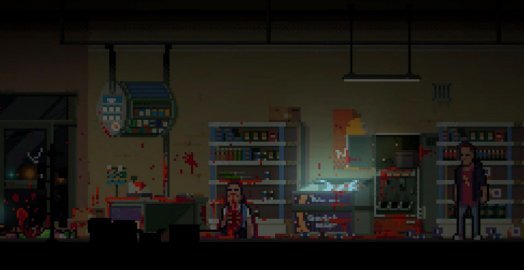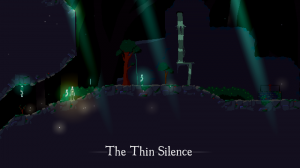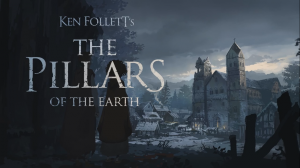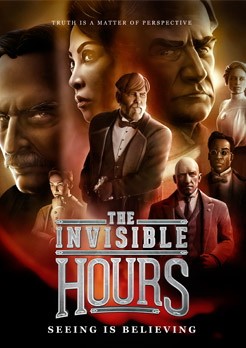Review for The Long Reach

For someone who rarely frequents horror movies, I was kept on the edge of my seat during my whole playthrough of the adventure thriller The Long Reach. The game tells a science-disaster-gone-wrong story with a splash of psychological terror and gory murders – especially gory murders – expressively painted in stylish pixel graphics. While offering only a rather hazy conclusion at the end, the plot twists, crazy killer chases, and the protagonist’s heart-pounding struggle for survival in his maniac-overrun office are more than enough to deliver a fun, late-night horror experience.
The series of murders begins in a lab where a group of scientists are holding a musical experiment. Stewart sits behind a piano and begins playing a tune that transitions into the title screen theme. Then everything turns black, with distant cries and screaming heard in the darkness, and when our view of the lab is returned, Stewart is sprawled on the floor. Waking up to complete silence, he soon finds that somehow all of his co-workers have gone berserk and their entire office has been turned upside down. With scientists turned into mindless killers wielding blades and whirring chainsaws now roaming around the blood-stained hallways, it’s up to Stewart to stop the madness once and for all.
Early on, there aren’t many characters that can help along the way, or even have a conversation with, except a woman named Shelly who is still alive and sane somewhere in the building. Shelly guides Stewart through phone calls around the building, specifically tasking him with finding a red button in the security room. The rest of their colleagues have either become zombie-ish killers or think they’re dogs. Most of them are trapped in intense states of hallucination – courtesy of the mysterious failed experiment – so it’s hard to know what they’re really like or who they were before this catastrophe took place. Stewart himself is vulnerable to such visions, which offers some really interesting turns of events. Sometimes he sees people when they are really just a stack of objects in the shadows, and other times he even ‘teleports’ to another realm.
The game is essentially divided into two different acts, with the first raising questions about the experiment, and the second getting more psychotic as Stewart hunts down the source of all this madness while battling his own side-effects. A bizarre cult that worships a guy named Alan becomes involved, while more friends and non-killer co-workers eventually show up, triggering conversations that may or may not help you understand the deadly situation at this facility. Unfortunately, none of the lengthy dialogues, clues or even dream-like sequences ever clearly resolves what really caused the massacre in the first place. I have a guess, but it’s left wide open to interpretation as the information provided offers only vague possibilities.
Presented as a side-scroller, The Long Reach is built around familiar keyboard mechanics to interact with the environment and let you run and hide from the mad scientists from time to time. When pausing the game, a map of the controls is conveniently displayed and the essentials are pretty simple: ‘E’ to use any items you find or have in your inventory, and ‘Shift’ to run (which I used almost all the time, with or without a killer behind me). This simplicity allows you to jump straight into the story, with just the short intro basically serving as a tutorial. Strictly text-based conversations with NPCs and the protagonist’s opinion on hotspots are the main drivers of player actions. You can also read emails whenever an interactive computer is available, which provide bits of information regarding Stewart’s colleagues and the experiment.
The charm of this game is partly due to its crisp pixel art that’s easy on the eyes. Even with this blatantly retro style, each environment makes you feel like you’re actually there, as if you're walking down a silent corridor with flickering lights inside a busted vending machine or electrical sparks from chewed cords peeking out from the broken lift. Every little touch exists to make the place as eerie and battered as possible, the kind of detail intended to make players wonder, ‘What the hell happened here?’ Disturbing finger paintings on a wall, a severed head on a table, and a strange pile of pizza in the corner of a room are just some of the abnormalities you’ll find within the building. Outside, a picture of city chaos in winter and a bloody massacre in a convenience store, to name a few memorable scenes, reveal that the fallout of this horrible experiment has already spilled out of control beyond the facility itself.
For all the in-game horrors, it’s surprisingly hassle-free to walk around and perform actions with the help of some simple but effective visual cues. The frames of certain doors, for example, occasionally change color from yellow to red to indicate whether a killer on the other side is drawing closer, standing in front of the door, or far enough away to resume sleuthing. The same goes for any interactive objects, which are outlined in yellow when Stewart passes by them, so if you run too fast you might just miss one.
Looping music plays whenever our main character is in a danger zone, with menacing over-the-top piano slams that always froze me, urging me to look around to check if there was a killer running after me. It eventually got less and less frightening once my brain became familiar with the tunes, but the cautiousness lingered. Even when out of danger, sometimes these eerie haunting hums can be heard in empty hallways, the only thing competing with it the sound of your own footsteps. Elsewhere all kinds of noises can be heard when Stewart approaches the source, ranging from a buzzing TV to running tap water, loud generators and the breeze of air coming from vents, creating a solid atmosphere.
In the midst of such fear and uncertainty, Stewart’s witty remarks throughout his item-collecting adventure allows for more lighthearted entertainment. Usually when you incorrectly try to pair one item with another, a generic rejection from the main character is all you get, but there must be at least eight or more response variants from Stewart, like ‘C’mon. This was a fantastic idea’ to ‘I’ve seen this work on YouTube.’ It can be misleading at times when you hear ‘Maybe I should try one more time,’ but once you’re used to his responses, you can tell which are pure sarcasm and which is a legit lead.
The inventory obstacles themselves require decent logic and generally aren’t too bizarre even though the themes and objects involved can be, like finding a way to appease Alan the cult-worshipped god, or discovering something to lure a killer. I had to check a walkthrough two or three times, but the problem was largely that I didn’t use enough imagination – or at least haven’t watched enough horror movies to know what to do next. Most objects won’t stay too long in inventory, so these puzzles might be quite easy for seasoned adventurers, but they still provide a moderate challenge from time to time, especially when an item requires several steps to unlock.
A couple of unique puzzles can be found during the more eventful parts of the game, such as collecting a particular number of items to crack a secret safe, or clicking bells to create the correct melody before you can access a certain entrance. Because these types of puzzles are so sparse, they feel like a surprise that breaks from routine, which is a nice addition to the gameplay, yet at the same time they can be more difficult given how different they are from the rest of the inventory-based tasks.
Beyond the traditional collection and use of objects, one of the more exciting parts of The Long Reach is whenever Stewart meets a killer in the hallways – I mean, everything just turns into a terror! The intense violin music gets louder and louder as the killer chases you until you find safety, holding your breath as you watch your foe looking around, barely missing spotting you.
Escaping deranged scientists might sound like an easy task, but it’s actually quite challenging initially, which I learned the hard way after experiencing my first death as the screen went red and a text message harshly declared: YOU DIED. Yes, you can hide in certain blind spots such as inside cabinets, under tables or in the darkest corner of a room, but if you’re a few seconds late in getting there or not even sure where to hide, you’re finished. The killer roars as he whacks Stewart with his weapon of choice. Every enemy involves different timing and strategies, so it’s always exciting and a bit panicky every time you meet a new one. I actually had to retry several times with a certain scientist, but thankfully you’re revived every time you die, right before the fateful encounter. These chases don’t occur all the time, but each and every one of them creates a memorable horror moment that’s sure to leave an impression. They’re almost like mini-bosses you have to ‘fight’ before you can enter certain areas.
After finishing the game in about three hours, I was relieved to have survived all those intense killer chases, but also left with tons of unanswered questions. Conversations with co-workers and NPCs in general are great, written like a real guy talking to real people – inside jokes and jaded responses and all – but they never really divulge much actual information. Most of the time they simply feel like listening to a stranger’s conversations about inner office politics. The only obvious things I learned were usually bits of mundane info on who worked in what division, or who came up with the idea for the Christmas party. Rarely did I learn anything satisfying that actually made me have an ‘Ah, I see!’ moment. I was always left relying solely on my own perception or assumptions about what actually happened.
Even without any solid understanding of the overall mystery, or any of the characters involved for that matter, The Long Reach still makes for an enjoyably creepy and entertaining adventure. Indie developer Painted Black Games seems to know what scares people – at least those like me who aren’t regular horror buffs – and are clearly having fun with it! The game manages to rise above its narrative shortcomings with its art direction and, of course, its familiar horror movie tricks that always manage to induce tension because here it’s you who’s tip-toeing behind doors or running the other way from a lurking killer. The craft on display really shows love for the survival-thriller genre, while adventure fans in general with the nerve to face this game's horrors will surely appreciate the many blood-splashed oddities throughout the journey.



























